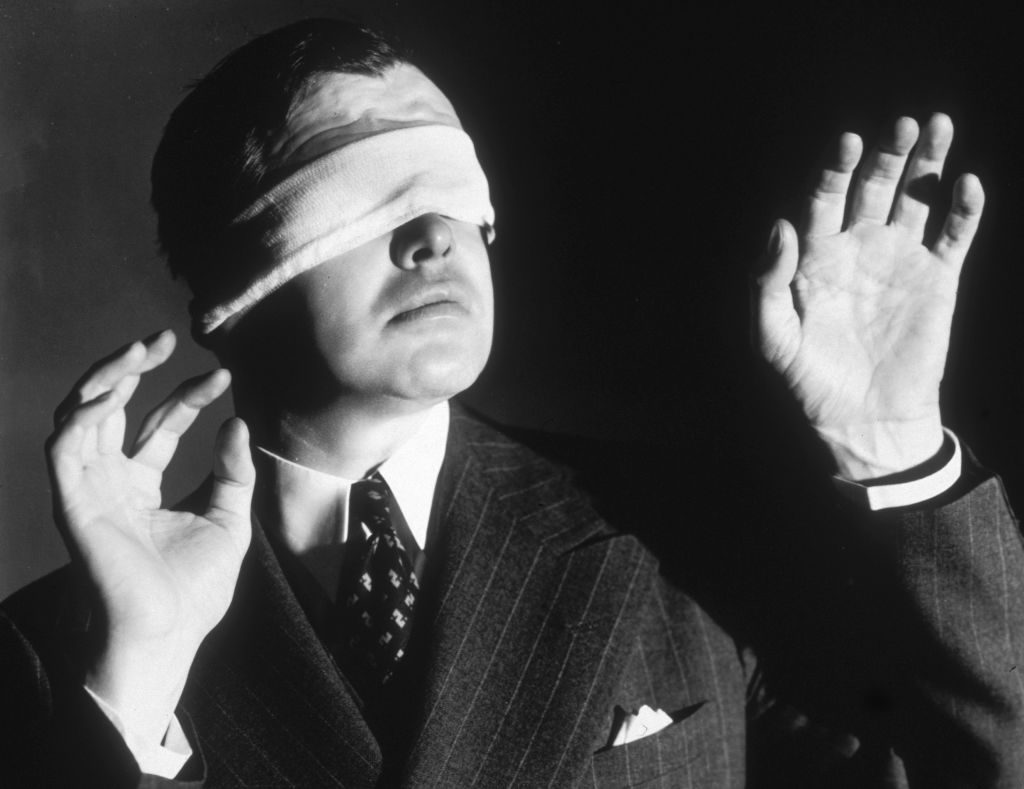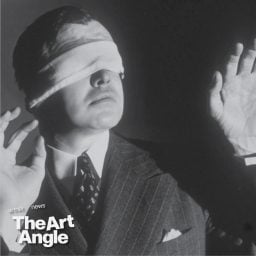This week, squinting into the future again…
A NEW YEAR’S TRADITION
‘Tis the season for freshly stripped Christmas trees to be abandoned on curbsides, for the post-vacation return to work to clarify how much every art professional actually loves or hates their job, and for yours truly to translate some of the industry’s dominant trends into a pack of predictions that can be objectively proven true or false by the end of the year. (You can see how I did in 2021 here.) With no further fanfare, here we go again…
1. Every major art fair this year will still require attendees to wear masks and present proof of COVID vaccination, a negative test, or sufficient antibodies.
From what I’m reading, Omicron’s off-the-charts contagiousness might make it the variant that finally transitions COVID into an endemic illness, meaning one so common and manageable that it no longer motivates states and businesses to maintain pandemic-level public-health restrictions.
Even if this proves true, however, I can’t envision any art-fair organizer retiring the measures that allowed major expos to return (in some form or fashion) last year until it’s indisputable that we’ve entered a post-pandemic era in every global art capital. Remember, they must observe whatever regulations municipal, state, and federal officials require of large gatherings regardless of their personal preferences anyway. Plus, my sense is that the overwhelming majority of exhibitors, collectors, and other industry players see mask and vaccination/testing mandates as a positive, especially with two years of elevated caution still tickling their brain stems. Why rush to dramatically increase the risk of getting sick during an important week just so your glasses won’t fog up?
In short, expect more of the same fair-entry procedures you begrudgingly accepted in 2021 to persist at every event held by Art Basel, Frieze, TEFAF, and the Armory Show in 2022.
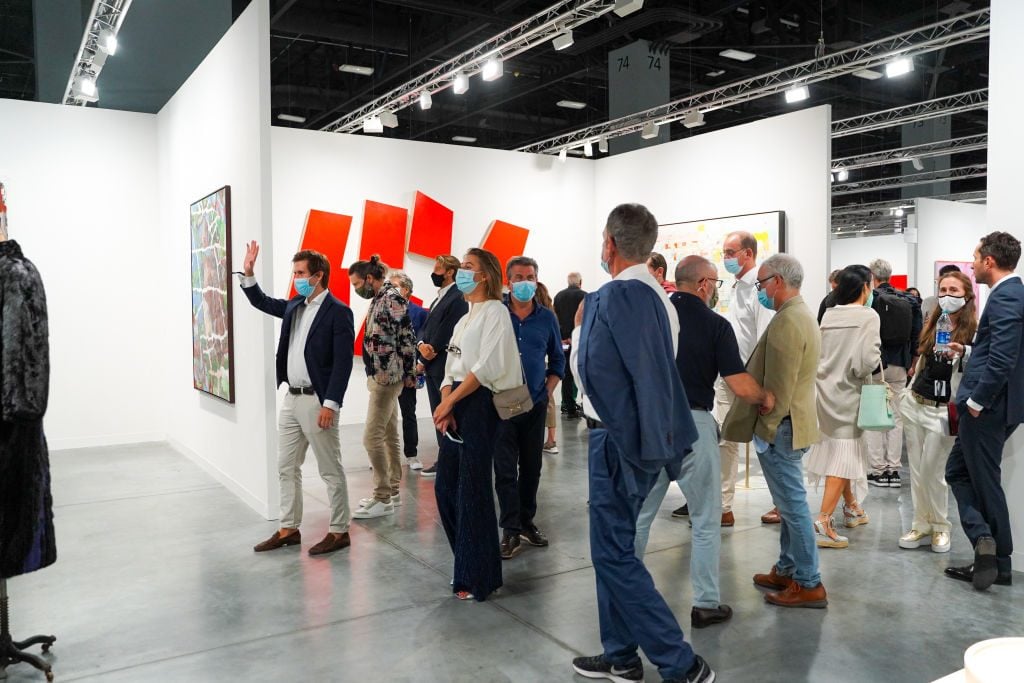
White Cube’s booth at the VIP preview for Art Basel Miami Beach on November 30, 2021. (Photo by Sean Zanni/Patrick McMullan via Getty Images)
2. A minimum of two high-ranking art-fair executives will leave for jobs in other sectors of the industry.
Name-brand officials at major fairs pulled their ripcords at an alarming rate between August 2020 and September 2021, as my colleague Katya Kazakina covered. At least two of the three most consequential farewells were triggered by job offers outside the art-fair gauntlet.
Noah Horowitz, the veteran director of Art Basel in the Americas, left last August to oversee Sotheby’s efforts to work with galleries and private dealers. Loring Randolph, appointed as director of Frieze New York in 2019, exited that post in September 2020 to direct the Nancy A. Nasher and David J. Haemisegger Collection in Texas. Roughly a year later, Rebecca Ann Siegel departed as director of Frieze Americas for opportunities yet to be announced.
Staging international art fairs hasn’t gotten any easier since these heavy-hitters said “thanks but no thanks.” Ongoing pandemic-induced regulations, dealers driving hard bargains after doing just fine without expos for a year, the need for nonstop travel, the pressure to please shareholders in a parent company with interests bigger than art (see: a newly James Murdoch-backed MCH Group, Endeavor, the Vornado Realty Trust)—it’s a lot. In fact, at least a couple more major players will decide it’s too much, and better gigs elsewhere in the field will be their rewards.
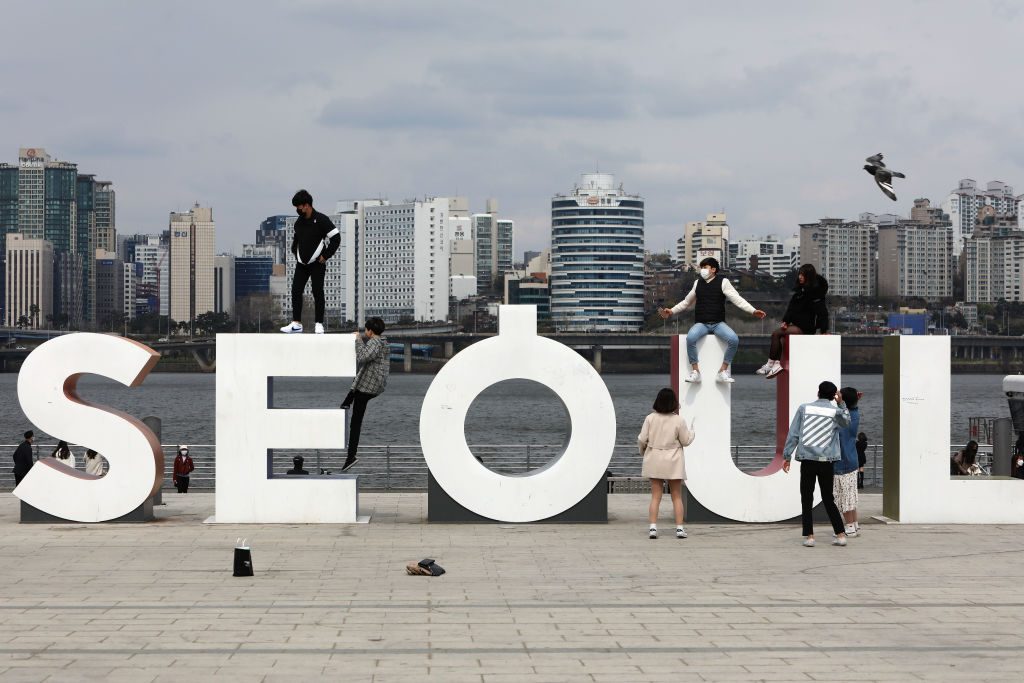
Seoul, South Korea, on April 12, 2020. (Photo by Chung Sung-Jun/Getty Images)
3. Western art sellers will announce more physical expansions in Seoul than in any other city on Earth.
The market is booming to historic levels across East Asia. But while there is still plenty of room to grow in Hong Kong (as evidenced by Christie’s and Phillips each announcing major upcoming expansions there), the city has probably already experienced its most spirited period of flag-planting by art sellers based abroad. How many major (and even mid-major) Western galleries really need a more robust presence near Victoria Harbor at this point, particularly as business and life in Hong Kong come to resemble their counterparts on mainland China more and more every day?
Instead, a growing faction of the Western trade looks poised to ride the wave to a destination a few hundred miles northeast: Seoul, another booming Pacific metropolis with a rich artistic tradition and an even richer collector base. Internationally headquartered dealers that have either recently opened or announced new permanent spaces in the South Korean capital include Gladstone, König, Lehmann Maupin, Pace (its second in the city), Perrotin, Thaddaeus Ropac (its first Asian location, period), and Various Small Fires. The scheduled debut of Frieze Seoul this September will only accelerate this momentum.
South Korean officials are also pumping in more boring-but-important incentives via the tax code; Seoul charges no import tax on art and no sales tax on works under 60 million South Korean won (about $55,000). Mix all these variables together, and no other locale should be as tantalizing to galleries and auction houses with grand ambitions in 2022.
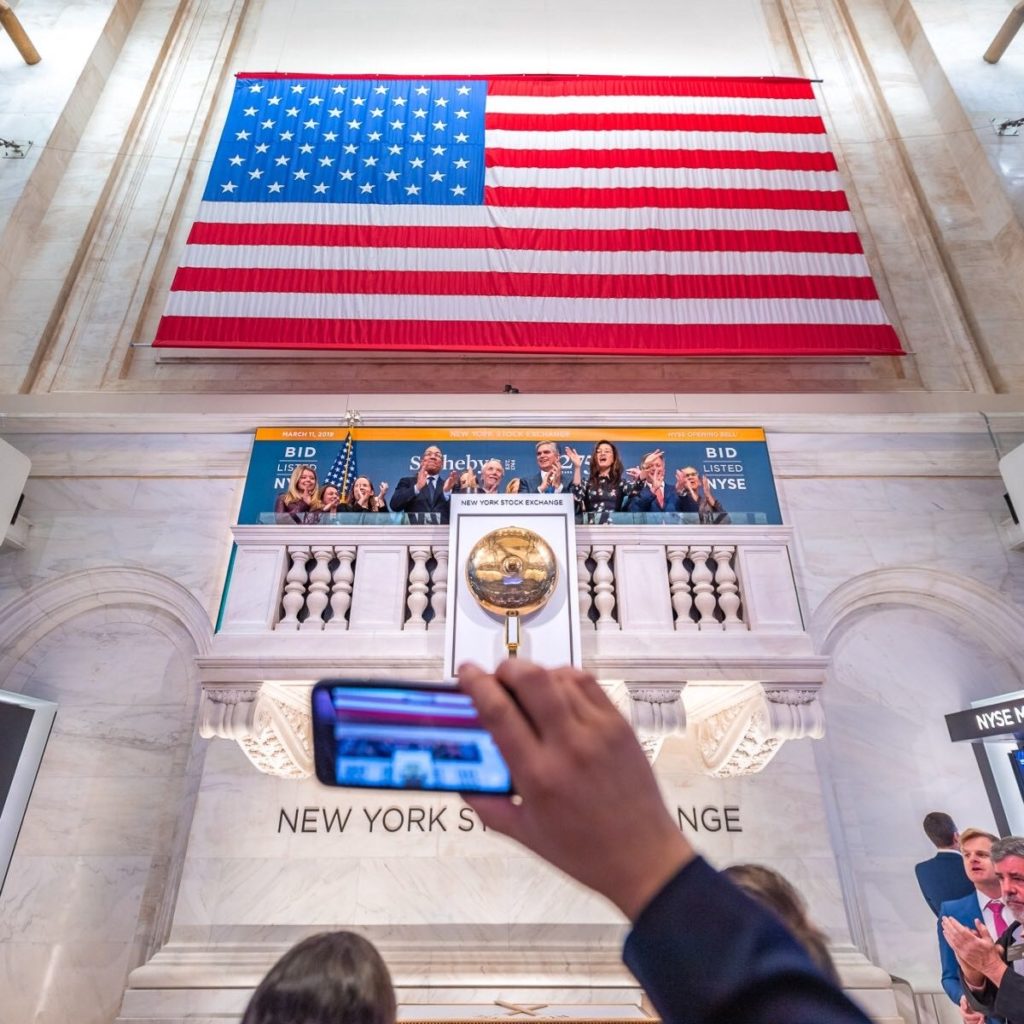
Sotheby’s at the New York Stock Exchange. Photo courtesy of Sotheby’s.
4. Sotheby’s will go public again, but the company’s share price will never top $63.
Bloomberg News reported in mid-December that Sotheby’s owner Patrick Drahi was exploring the prospect of re-listing the auction house as a public company. (A Sotheby’s spokesperson declined to “comment on rumors or speculation.”) Katya recently pointed out that Drahi has a long history of shifting his companies between public and private ownership when a switch is financially advantageous—and that a slew of moves just drove Sotheby’s to its best annual sales total ever ($7.3 billion). Barring a sudden economic downturn, that success—combined with the boisterous past year in the IPO space—makes it feel like a foregone conclusion that the world’s oldest auction house will return to a public stock exchange in 2022.
Just don’t expect unprecedented performance once it crosses over. The investment bank(s) tasked with shepherding a company into the public realm traditionally price the offer low enough to enable a first-day “pop” of 15 to 30 percent. Sotheby’s share price jumped to an all-time high of around $59 when news of Drahi’s acquisition hit the wire in June 2019, and shareholders ultimately received $57 in cash per share when the deal was finalized. The relisted stock should IPO well below that altitude to spur buyers into action, and I’ll be surprised if investors decide before the year is out that Drahi has transformed Sotheby’s prospects thoroughly enough for a market to develop at a price more than a few percentage points above its historical zenith.
5. The total value of fine art sold at auction through November 2022 will be less than for same period in 2021 (after adjusting for inflation).
Last year’s auction-market surge blew out of a perfect storm: tremendous growth in the investor class’s net worth thanks to a propulsive year in the stock market; pent-up demand for trophy lots that consignors held back from digital-only sales (satisfied most powerfully by the long-awaited debut of the Macklowe collection last November); a power-up in the Big Three houses’ digital infrastructure; and the surging popularity of NFTs, which added hundreds of millions of dollars to auctioneers’ bottom lines.
I expect fine-art sales at auction in 2022 to stay very healthy. I just think one or more cogs in the machine will slip far enough out of the groove to make last year’s total unattainable.
6. For the second consecutive year, more than half of the U.S. museum directors hired will be women and/or BIPOC.
Dynamo Artnet News contributor Zachary Small reported in late November that the majority of stateside museums that hired leaders over the past year “have chosen women and BIPOC candidates to lead their organizations,” including the Bronx Museum in New York, the Museum of Contemporary Art Los Angeles, and the St. Louis Art Museum in Missouri. That qualifies as a serious sign of progress in a field long known to be shamefully behind on issues of DEAI (diversity, equity, accessibility, and inclusion), especially at the top of the org chart.
I won’t speculate about how many of the 22 director’s chairs open at the time of Small’s piece will have new occupants by 2023. However, the institutional and cultural trend lines lead me to believe that white guys will, refreshingly, make up the minority of those hires again. If only this could have happened before helming a cultural institution became one of the most thankless knowledge-work jobs in America…
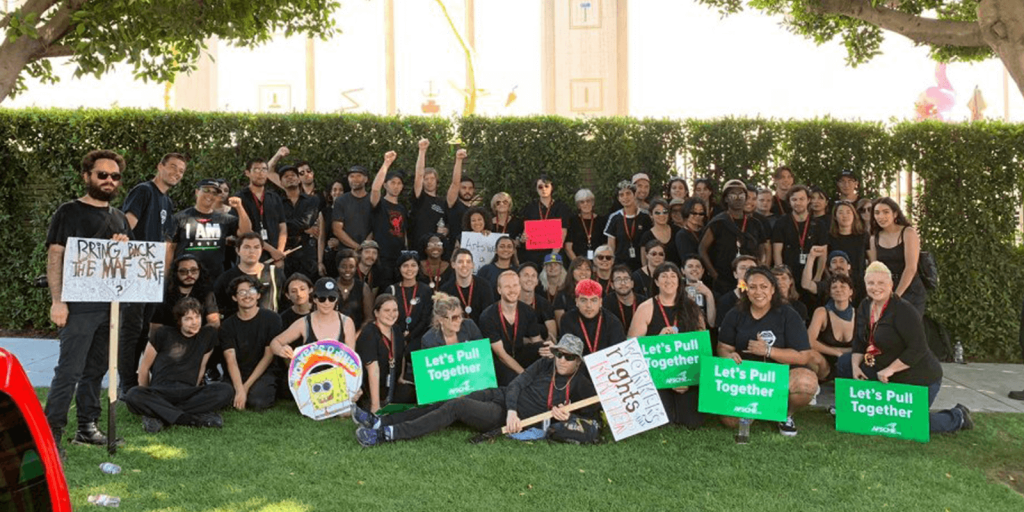
The Marciano Foundation visitor services workers during their union drive. Photo courtesy of AFSCME District Council 36.
7. Staff members at more U.S. art institutions will vote to unionize, but the labor movement will not make strides into the for-profit side of the art business.
Workers voted or announced their intent to establish unions at four U.S. cultural institutions last year: the Baltimore Museum of Art, the Brooklyn Museum, the Hispanic Society in New York, and the Whitney. In February, management at the Solomon R. Guggenheim Museum also finalized a contract with workers who unionized in the summer of 2020. These were only the latest victories in a labor movement that started gathering strength and making change in the museum sector years earlier.
Even before COVID struck, the costs of working in U.S. art institutions generally far outweighed the benefits. So it seems like a mortal lock to me that staffers at a minimum of one more museum will unionize before the year is up.
Just don’t hold your breath for similar solidarity at even the largest galleries, auction houses, or art-services companies around the country. Labor organizers have recently harnessed long-simmering injustices to notch big wins over for-profit companies ranging from John Deere to Google. But with few commercial art businesses carrying more than a handful of employees, and no clear union precedent for their staffers to follow, a for-profit art workers’ union still feels out of reach right now.
8. Beeple will sign with one of the Big Three entertainment agencies (CAA, Endeavor, or UTA) before he signs with a gallery.
My colleague Kenny Schachter relayed rumors that NFT messiah Mike Winkelmann flirted with Pace Gallery honcho Marc Glimcher last June, then months later pitched his practice to Larry Gagosian by promising he would make “a shitload of money,” according to a source Kenny labeled “unassailable.” It’s inevitable that Beeple will ink a high-end gallery representation deal soon, right?
Maybe, maybe not. Beeple is set to open a solo show at New York’s Jack Hanley Gallery this March, according to Jerry Saltz (cheers to Kenny for the alert), but as of now there are no definitive signs that it will be an ongoing artist-dealer relationship.
In a variety of ways, 2021 proved that major crypto artists need galleries and big auction houses a lot less than galleries and big auction houses need them, at least if those old-world institutions want to make a mark in the blockchain business. I think there’s a compelling case that Beeple could wring much more fame and money out of his intellectual property through licensing deals, transmedia collabs, video games, and TV than by staging exhibitions inside a white cube.
Larva Labs cofounders Matt Hall and John Watkinson, the creators of the now-ubiquitous CryptoPunks, apparently agreed with this logic. They inked a deal with UTA last August. It would make sense for Beeple to prioritize a similar pact over gallery representation (particularly since he already knows he can sell ambitious new physical artworks directly through Christie’s for a fat guarantee if he wants to).
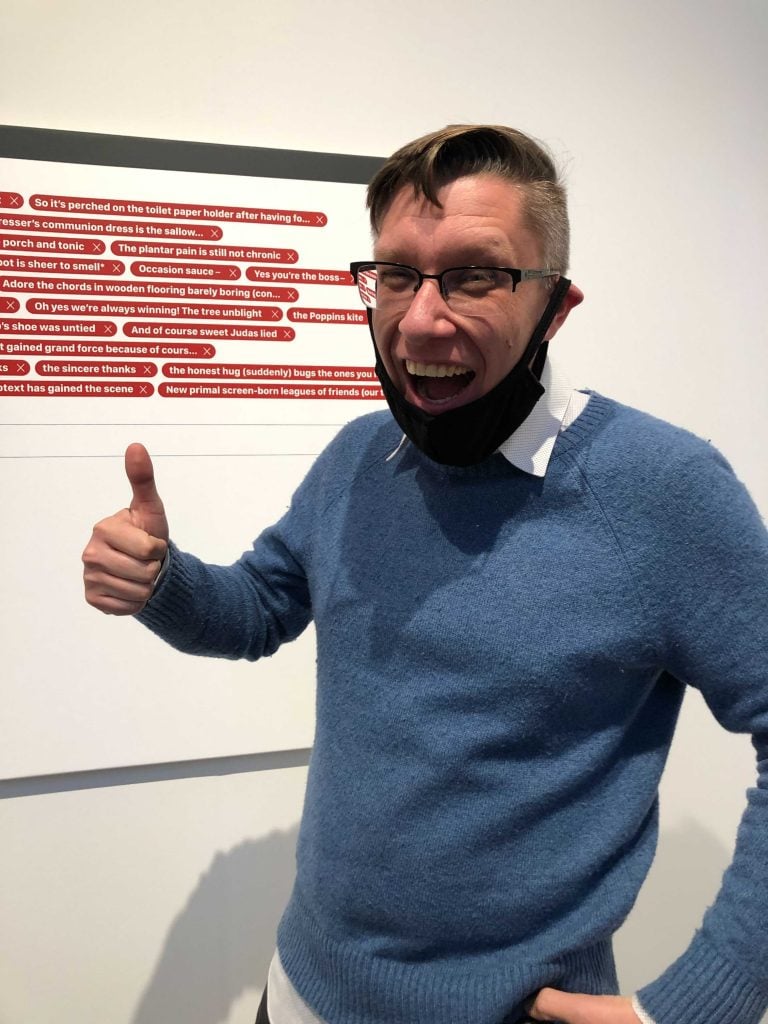
It’s Beeple! He’s also known as Mike Winkelmann. Photo: Katya Kazakina.
9. No single NFT will sell for more than $25 million on any platform.
I’m not making this prediction because I’m sick of hearing about Beeple’s Everydays: the First 5000 Days blasting off for $69.3 million at Christie’s last March. I’m making it because that one outlier result has warped way too much of the discourse around art and crypto, and I think we’re due for at least a modest correction.
The Everydays spectacle papered over the fact that no other strictly digital, “one-of-one” NFT work sold for more than $6.6 million during last year’s crypto bonanza. (I’m excluding Beeple’s HUMAN ONE, which brought $28.9 million at Christie’s 21st century evening sale in November, because the NFT was linked to a massive sculpture with an ever-changing video component.) Even the highest-selling PFP NFT, CryptoPunk 7523, topped out at $11.75 million.
In a vacuum, whether you anchor this discussion to $6.6 million or $11.75 million, it’s still a ton of money for a work in a medium that most of the art world didn’t even know existed a year ago. Yet those two options are, respectively, only about one-tenth and one-sixth of the price that the average art pro’s brain conjures whenever the NFT market is mentioned today. It feels risky to underestimate the wealth, marketing prowess, and self-dealing capacity of the high-end crypto space, but I’ll wager that NFT bidding won’t even get halfway to Everydays this year.
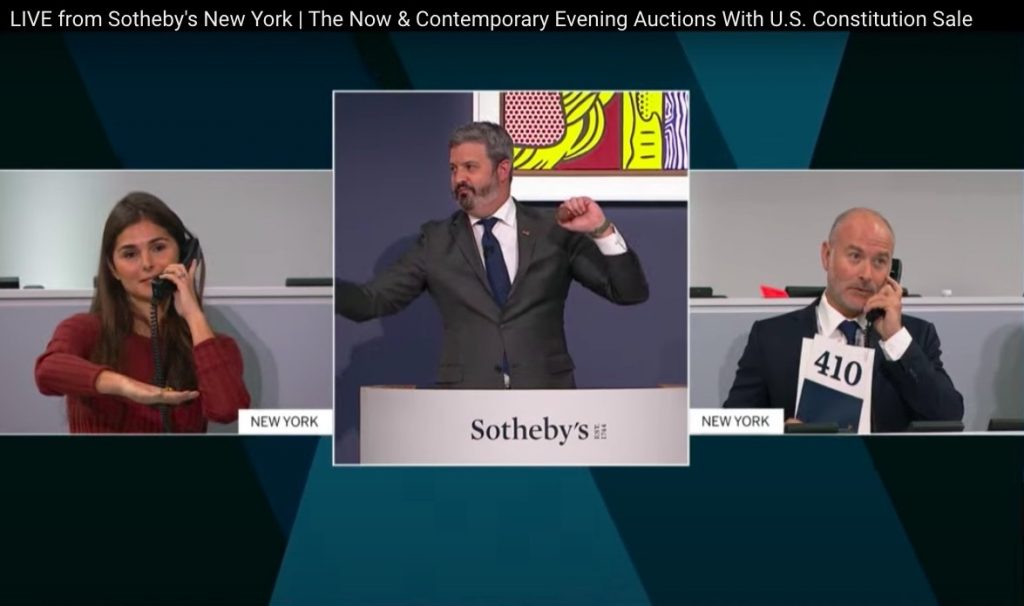
Screenshot of the Sotheby’s sale of the U.S. Constitution. David Schrader (left) bid on behalf of ConstitutionDAO.
10. A Decentralized Autonomous Organization (DAO) will win at least one auction lot for $1 million or more.
For those unfamiliar with the linchpin concept in this prediction, a DAO is an entity formed (often, rapidly) by a group of people who share a common goal they hope to accomplish by collectivizing their decision-making on the blockchain. Think of it as a company (or maybe a political action committee) where voting power corresponds to the amount of cryptocurrency each member has contributed to the cause, with their every move and preference recorded digitally.
Anyone who didn’t need that little preamble is probably already aware of the story of ConstitutionDAO, which crowdfunded roughly $47 million from around 17,000 people to try to buy and publicly display a first printing of the U.S. Constitution offered at Sotheby’s last November. Although the DAO ultimately lost the bidding war to hedge-fund magnate Ken Griffin (partly thanks to the arcane financial engineering of irrevocable bids), it succeeded in getting a global auction house to recognize the validity of the structure, as well as created a strategic template for future DAOs to improve upon. I suspect another DAO will follow those lessons to the winner’s circle before the year is up.
Just don’t be surprised if the target is something other than an artwork. We’re more likely to see the necessary popular interest and resources fixate on another hallowed document, a historic object, or a monumental fossil. If you’re sitting on, say, a pristine T-Rex skeleton, now is the time to bring it to market.
After the madness of the past two years, I can’t think of a more appropriate transition to what lies ahead of us than the prospect of thousands of anonymous cryptocurrency holders remotely bidding up dinosaur bones at one of the oldest, toniest art sellers on the planet. One thing I’m absolutely sure of: 2022 will be another wild ride.
